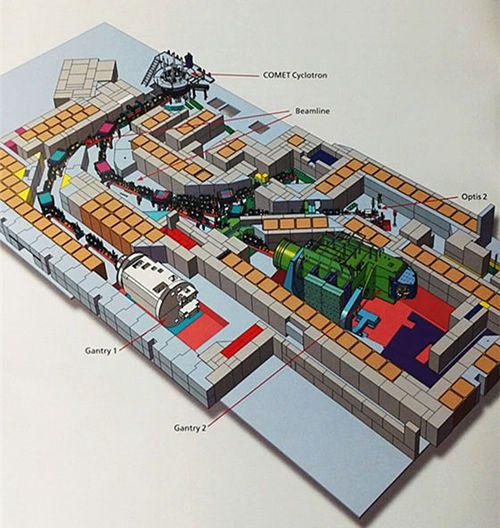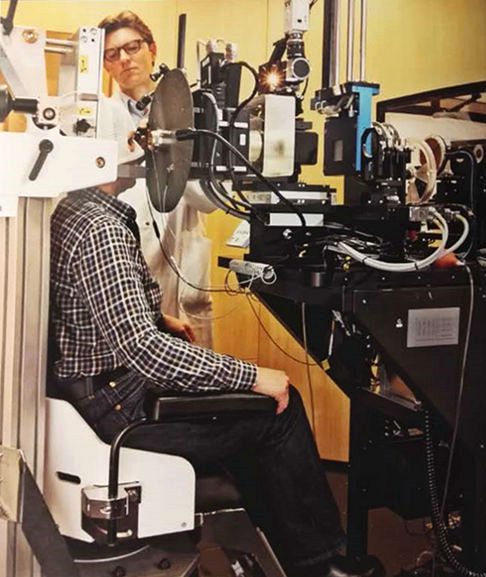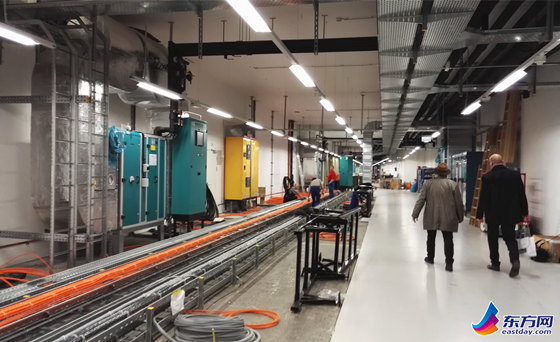瑞士最大的研究所PSI如何开展质子医疗

(File
photo 资料图)
China's first and world's third
medical institute equipped with the proton and heavy ion therapy system, Shanghai
Proton and Heavy Ion Center has operated smoothly for one year. Eastday
reporter recently visited the Paul Scherrer Institute (PSI) in Switzerland,
which also provides proton therapy.
中国第一家、全球第三家同时拥有质子重离子放射治疗设备的医疗机构,上海市质子重离子医院已顺利运行一年。东方网记者近日赴瑞士访问期间,参观了同样拥有质子疗法的保罗谢尔研究所(PSI)。
Tumours
of the eye were treated with proton at PSI for the first time in 1984. This was
the first installation of this type anywhere in Europe. The technique known as
spot-scanning, used to treat deep-seated tumours with protons, was developed at
PSI at the beginning of the 1990s.
1984年,PSI首次通过质子治疗眼睛肿瘤,这是欧洲第一次安装这种类型的设备。90年代初,PSI开发出更为精准的、用于治疗深部肿瘤的点扫描技术。
Proton
therapy
什么是质子治疗?
Proton
therapy, in simple words, is to use charged particles, called protons, to
destroy cancerous tissue by means of precise positioning. Protons
can exert their greatest impact deep within a patient's body, inside the tumour
itself. Thanks to an irradiation technique, the innovative proton therapy
facility at PSI is able to adapt the radiation dose extremely accurately to the
shape of a tumour (which is usually irregular). As a result, this technique is
able to safeguard healthy tissue better than the conventional modern
radiotherapy techniques.
Currently, proton or heavy ion therapy
system is internationally recognized as the most sophisticated radiation
therapy technology for its good effect and little side effect.
质子疗法,简单说就是通过精准定位,“定向爆破”恶性肿瘤,避免误伤健康组织。质子能深入病人身体里,在肿瘤内部发挥最大的作用。以PSI为例,凭借先进的辐照技术和创新的质子治疗设备能准确地根据肿瘤的形状(通常是不规则的)来调整辐射剂量,因此能更好地保护正常组织。
运用质子或重离子射线治疗肿瘤,是当今国际公认的最尖端的放射治疗技术,其以杀癌效果好、毒副作用小而被誉为“治癌利器”。

The
overall technical facility for proton therapy at PSI (File photo)
PSI质子治疗整体技术设施(资料图)
A patient was treated with protons for
the first time at the Lawrence Berkeley Laboratory in California (USA) in 1954,
and the first proton therapy programme in Europe ran in Uppsala (Sweden)
between 1957 and 1976. In 1961, the Harvard Cyclotron Laboratory and the
Massachusetts General Hospital in Boston, USA, started a proton therapy
project. The first proton therapy facility to be used at a hospital went into
operation at the Loma Linda University Medical Center, California, in 1990.
世界上第一例质子治疗是1954年在美国加州的劳伦斯伯克利国家实验室里。欧洲第一个质子治疗方案于1957年到1976年在瑞典的乌普萨拉运行。1961年,美国波士顿的哈佛回旋实验室和马萨诸塞州总医院启动了一项质子治疗项目。1990年,第一个在医院使用的质子治疗设备在加州的洛马林达大学医学中心投入运行。
Proton
therapy process at PSI
PSI的质子疗程
At present, PSI treated about 4700
patients with proton therapy every year. A course of treatment usually lasts
six to eight weeks. Most of the patients are referred through university
hospitals and other hospitals in Switzerland and abroad, and are then looked
after by a qualified team of radio-oncologists, medical physicists and other
specialists at PSI.
目前,PSI每年接受大约4700名患者实施质子治疗。一个疗程通常持续6到8周。大部分病人来自大学医院和其他在瑞士或国外的医院,然后由PSI的放射肿瘤学家、医疗物理学家以及其他专家组成的团队收治。

PSI proton therapy
for tumours of the eye (OPTIS) (File photo)
PSI用质子技术治疗眼睛肿瘤的设备(资料图)
According to the introduction provided
by PSI, after producing an individual mould to support the patient's body,
computer tomography images are taken slice by slice. The PSI medical team then
establishes the dose boundary for each plane of the tumour, i.e. the
three-dimensional target volume with a safety zone. This forms the basis of the
treatment plan, in which computer programs developed specially for this purpose
at PSI pre-calculate, optimize and store every setting of the radiation
equipment in a dataset, together with the resulting dose distribution.
据PSI介绍,在制作好支撑病人身体的独立模具后,计算机会逐层拍摄断层扫描图像。然后,PSI的医疗团队将建立肿瘤每一面的剂量边界,即在安全区域内的三维目标量,由此形成治疗方案的基础,其中,PSI为这一目标特别开发的计算机程序将提前计算、优化,并在数据集里存储辐射设备的每一组设置和产生的计量分布。
X-ray images are used to check the
location of the tumour and the patient's position within their individual
moulded support at each treatment session. Patients undergo regular follow-up
checks for several years after the course of treatment is over.
X光图像则被用来检查肿瘤的位置,以及各个治疗环节中患者在他们各自模具支持下的状态。在治疗结束后的几年,患者将定期进行随访检查。
The medical team will need all the
available information, including previous investigations, medical history and
radiological documentation, in order to prepare and implement a course of
proton therapy. Direct contact with the doctor referring the patient is also
very important to ensure that good care is provided before and after the
therapy at PSI.
从质子治疗开始前,医疗团队就需要所有可用的信息,包括病人以往的检查,医疗史和影像学资料,以准备和实施治疗。而与医生的直接沟通,对治疗前后的良好护理也至关重要。
In Switzerland, the cost of treatment
for some indications is currently paid by the compulsory health insurance
scheme:
在瑞士,部分质子治疗的费用可由强制医疗保险计划支付。
About
PSI
关于PSI

Dr. Rafael Abela, SwissFEL, Projecktmanager Photonics
Rafael
Abela博士,瑞士X射线自由电子激光器,项目经理,光子学
The Paul Scherrer Institute (PSI) is
the largest research institute for natural and engineering sciences in
Switzerland, conducting cutting-edge research in the fields of matter and
materials, energy and environment and human health. PSI develops, constructs
and operates complex large research facilities. Every year more than 2500 guest
scientists from Switzerland and around the world come to PSI. Like PSI's own
researchers, they use the unique facilities to carry out experiments that are
not possible anywhere else.
保罗谢尔研究所是瑞士最大的科研机构,致力于自然和工程科学,在物质与材料、能源与环境和人类健康领域开展尖端研究。PSI开发、建设和运作复杂的大型科研设备。每年,超过2500位来自瑞士和全球的客座科学家到访PSI。跟PSI自己的研究人员一样,他们使用PSI独特的设备来进行在别处不可能实施的实验。
Prof. Dr. Joël Mesot, Director PSI
introduced that the staff come from 58 countries with the number of Chinese
employees is the fifth largest. Half of the guest users (from circles of academy
and industry) who use PSI facilities are from Switzerland
and the other half from all over the world and among this, 1% is from China.
保罗·谢尔研究所主任Joël Mesot博士介绍说,PSI的雇员来自58个国家,中国员工的数量占第五位。而在使用PSI科研设备的外来用户(包括学术界、工商界)中,50%来自瑞士,50%来自世界各地,其中,中国占1%。

Swiss X-Ray
Free-Electron Laser Center
瑞士X射线自由电子激光器设施中心
In
addition, there are about 50,000 persons including teenagers coming to
PSI for visit every year. PSI is pleased to see more and more young people love
science and technology.
此外,每年还有大约5万人来PSI参观,包括十二、三岁的小孩子。PSI对此十分欢迎,并希望有更多年轻人对科技感兴趣。
It
is worth mentioning that Swiss X-Ray Free-Electron Laser is now under
construction at PSI. It is scheduled to complete at the end of the year and
start for experiments from the beginning of next year.
值得一提的是,PSI当前正在建设瑞士X射线自由电子激光器设施中心,这个工作站大约今年年底完成,明年初就能开始做实验。





